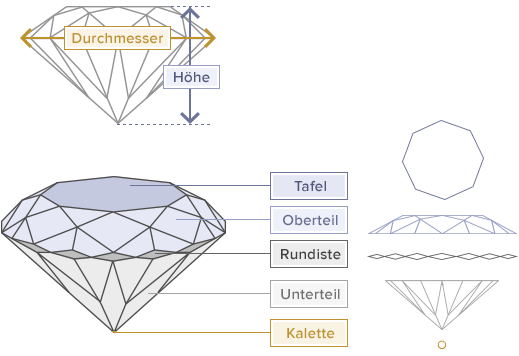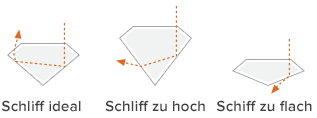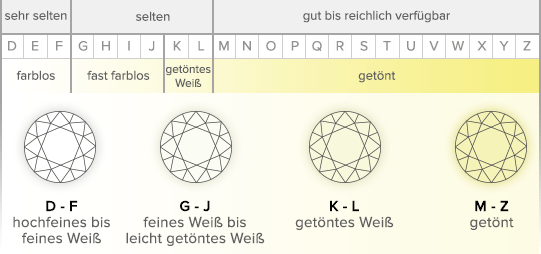The 4 "C "s of diamonds
The brilliant formula for determining the value of diamonds
Graduating diamonds based on four main criteria
Coin collectors pay attention to the surface of their treasures, stamp lovers look very closely at the teeth of a stamp - but how do experts decide on the quality of a diamond? The most important criteria can be summarized in a simple formula: Four terms, all of which begin with the letter "c" in English, stand for the most important clues. Carat, Color, Clarity and Cut are the measure of all things on the diamond market. They provide information about the real value of a diamond. Internationally, diamonds are graded according to the rules of the International Diamond Council (IDC), which is why all grading information in our offer overview corresponds to this standard.
The GIA explains how a graduation takes place according to the 4 C's:
Graduation of Diamonds Part 1
Graduation of diamonds part 2
Cut
Basically, diamonds are natural products. Only in the cut of the diamond man intervenes. It is the cut that gives diamonds the shine and luster that have made diamonds the epitome of wealth and prosperity. By cut is meant not only the shape of the cut, i.e. brilliant, oval, marquise, drop, heart, emerald cut or princess, but its exact execution: the cut is an art in itself, correct proportions and the arrangement of the facets determine the appearance of the diamond. Five quality grades between "excellent" and "low" are distinguished. These are awarded individually for proportions, symmetry and polish.
Only if the cut is successful in terms of proportions, symmetry and polish can it be graded as "excellent" or "very good". You can see how a cut grading is done here:
Diamond Cut

Decisive for the brilliance and fire of a diamond are the proportions: Only if these are optimal, the light penetrates the stone as desired and ignites the luminous fire:

Color (Color)
Actually, the diamond is called a colorless stone - but most stones are tinted: In fact, high-fine white is extremely rare, as are diamonds with a pure color. Brown diamonds are most common. The colors of diamonds are designated in categories from "D" (high fine white +) to "K" (tinted white) to "Z" (tinted). Today, there are a total of 23 color classes:

The following video impressively shows the different color gradations in nature:
Color of diamonds
Clarity
Diamonds are particularly valuable when they are flawless, i.e. when no inclusions are visible. Only if no inclusions are visible under tenfold magnification, one speaks of flawless diamonds. If inclusions are present - which often occurs due to the natural formation of diamonds - the value is higher the smaller they are.

The rating of clarity is done in ten grades from "IF" (flawless without any internal features) to "Piqué 3" (here inclusions are easily visible to the naked eye). However, testing with the naked eye is not sufficient because many inclusions only become visible when viewed with multiple magnifications:
Inclusions in diamonds
Carat (Carat)
This unit determines the weight and therefore the size of a diamond. One metric carat is exactly equal to 0.2 grams or 100 points. A value parameter of a brilliant diamond is the carat number. Originally, the term "carat" comes from a natural unit of measurement, namely the seeds of the carob tree. Here, the value of a diamond increases disproportionately to its weight. A two carat diamond is worth significantly more than two single carats of the same quality.
The following table gives the approximate diameters of diamonds:
| Weight |
Diameter |
| 0,25 ct | 4.2 mm |
| 0,50 ct | 5.2 mm |
| 0,75 ct | 5.9 mm |
| 1,0 ct | 6.5 mm |
| 1,25 ct | 7.0 mm |
| 1,50 ct | 7.4 mm |
| 1,75 ct | 7.9 mm |
| 2,0 ct | 8.2 mm |
| 2,25 ct | 8.6 mm |
| 2,50 ct | 8.9 mm |
| 3,0 ct | 9.4 mm |
| 3,50 ct | 9.9 mm |
| 4,0 ct | 10.4 mm |
| 5,0 ct | 11.2 mm |
| 6,0 ct | 11.9 mm |
| 7,0 ct | 12.2 mm |
| 8,0 ct | 12.5 mm |
| 9,0 ct | 13.1 mm |
| 10,0 ct | 13.6 mm |
| 15,0 ct | 16.1 mm |
| 20,0 ct | 17.7 mm |
| 30.0 ct | 20.3 mm |
| 40.0 ct | 22.3 mm |
| 50.0 ct | 24.1 mm |
| 100.0 ct | 30.3 mm |
As a general rule, the value of a diamond increases as the number of carats increases.
Diamond carat number
|
At a glance: The most important four characteristics of a diamond |
|
|
Cut |
Cut design with five quality levels from "excellent" to "low", as well as indication of various cut shapes (for example, brilliant, marquise, drop or heart) |
|
Color |
Color with 23 classifications from "high fine white +" (D) to "slightly tinted white" (J) to "tinted" (Z) |
|
Clarity |
Clarity with ten grades from "IF" (flawless with no visible inclusions) to "Piqué 3" (where inclusions are easily visible to the naked eye) |
|
Carat |
Weight equivalent to 0.2 grams or 100 points |







